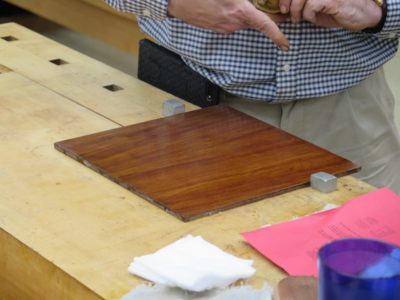Plywood Agonistes

Many, many moons ago I settled on a curriculum for my workshops on Historic Woodfinishing, a curriculum based on a series of finishing exercises that would yield a set of sample boards for each student to keep. I originally instructed each student to bring a small finishing project for us to work on during the class, but the wild variety of those projects made it too troublesome to make sure everyone got the learning experience I had in mind. Hence, the plywood panels.

For the first 25+ years this syllabus worked just fine as good quality plywood for the sample boards was easily and inexpensively obtained. I would buy a stack of 24″x48″ birch or luan panels to use (frequently I could find luan plywood that was very mahogany-like) and all was well. The first chink in that regimen was after the Iraq war when vast quantities of building supplies in the mid-Atlantic were going overseas to rebuild that region, but even though local inventories were diminished and prices increased I could find the necessary materials. After that stretch things got better again and I could find pretty good 24″x48″x 1/4″ birch panels for around $9 and luan panels of the same dimension for about $5.
Then came the increasing disruptions with industrial inventories, culminating with the imposed collapse of the supply chain three years ago. Ever since it has been a real chore to find the requisite supplies for a workshop at a reasonable price. As a result I have always been on the hunt for acceptably good quality/affordable plywood for use in the classes, frequently “stopping in for a look” at almost every lumber yard to check out their inventory. There was a stretch of time where even garbage inventory was running almost $40 for the birch panels and $25 for the luan. The culmination of my struggles played out in my most recent workshop last month when the supply of materials I could find was really not acceptable for the workshop outcome I desired, to the point where I apologized to the students and will in fact be making a new set of sample boards to send to each of them.

Yes, I know this is mahogany lumber, but it does reflect the quality of plywood I was looking for. Pad polishing on an exquisite surface makes the whole enterprise a resounding success.
Recently while visiting my daughter I was pleased to find some better-quality plywood panels at a less heart-attack-inducing price and bought a stack that should serve me well for the summer upcoming. Still, while visiting her I called around to find some premium plywood, either mahogany or walnut, to provide one or two small pieces for each student to go along with the luan and birch. Much to my delight I found a place about twenty miles away that had what I wanted! I arranged to go there last Friday to pick up a couple of sheets.
As I piece together the threads of the story, the lumberyard was a father-and-son operation that was based on them building custom cabinetry. Over the years they had built a sideline of ordering excess materials for their projects into a thriving but small premium lumber and plywood operation. It was with great anticipation that I set out for their place. Little did I know at that moment that an electrical fire two days earlier had burned their shop and warehouse to the ground, destroying all the tools and machines they used for their cabinetmaking and all of the inventory in the connected small warehouse. It was clear that they were still in shock, but hopeful that they could rebuilt their business with help from friends and customers who were already giving them tools and machines to get the ball rolling. The hardest nut to crack will be their status as completely uninsured. They will have to rebuild completely on their own resources.
The conversation with them, looking out over the still freshly burned building, made me reflect on two other catastrophic fires in recent years. First was that of my penpal from the Great California Fire three years ago, when it wasn’t just his shop that burned down, the whole town was left looking like Hiroshima. A second was a shop fire for a notable furniture maker in NYC. In the latter case I contributed substantially to the GoFundMe effort, in the former I packaged and sent several boxes of tools and supplies to help a comrade-in-arms get going again.
Which somehow brings me back to the status of activities at the barn. I spoke yesterday with my faithful insurance agent who confirmed that the carrier for the business activities of the barn has terminated my coverage, and despite his yeomanlike efforts he cannot find another carrier to provide me with business liability insurance. Goodbye workshops.
Plus, these vignettes have drawn my attention to be even more conscientious regarding to fire risk in my own shop.
Lastly, it reconfirmed for me the virtue of us taking care of each other in times of need. I have very little sympathy for the indolent, but an immense inclination to care for those to whom care is needed. I hope you will as well.


Join the Conversation!